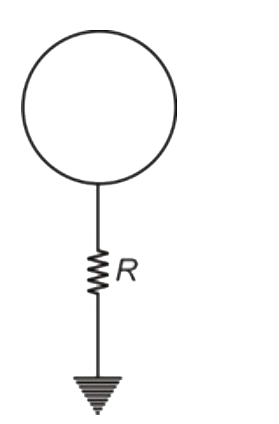Explain why a charged balloon is repelled by another charged balloon?
A charged balloon is repelled by another charged balloon because both have the same charge. And we know similar charges repel each other. But a charged balloon attracts an uncharged balloon as there is always an attraction between a charged and uncharged object.
Similar Questions
A conducting bolloon of the radius a is charged to potential V0 and held at a large height above the earth ensures that charge distribution on the surface of the balloon remains unaffected by the presence of the earth. It is connected to the earth through a resistance R and a value in the balloon is opened . The gas inside the balloon escapes from value and the size of the balloon decreases. The rate of decrease in radius of the balloon is controlled in such a manner that potential of the balloon remains constant. Assume the electric permittivity of the surrounding air equals to that of free space (ε0) and charge cannot leak to the surrounding air.

The rate at which radius r of the balloon changes with time is best represented by the equation
View SolutionIf a person lives in an area which has just been hit by a cyclone, The following precautions should be observed:
View Solution
Knowledge Check
Which of the following statements best explains why a closed balloon filled with He gas rises in air?
AHe is monoatomic gas, where as nearly all molecules that make up air are diatomic eg:
N2,O2 etc.BUavg of He is higher than Uavg of air molecules and higher speeds of collisions with the balloon walls proped the balloon upwardCBecause the He atoms are lighter than average air molecules, as a result He (g) is less dense than air. The mass of balloon is thus less than the mass of air displaced by its volume.DBecause he has lower molar mass that the average air molecules, the He atoms are in faster motion. This means temperature of He is higher than the air temperature, hot gases tend to rise.Explain why a charged balloon is repelled by another charged balloon whereas an uncharged balloon is attracted by another charged balloon?
AMuscular forceBElectrostatic forceCmagnetic forceDGravitational forceA conducting bolloon of the radius a is charged to potential V0 and held at a large height above the earth ensures that charge distribution on the surface of the balloon remains unaffected by the presence of the earth. It is connected to the earth through a resistance R and a value in the balloon is opened . The gas inside the balloon escapes from value and the size of the balloon decreases. The rate of decrease in radius of the balloon is controlled in such a manner that potential of the balloon remains constant. Assume the electric permittivity of the surrounding air equals to that of free space (ε0) and charge cannot leak to the surrounding air.

The rate at which radius r of the balloon changes with time is best represented by the equationAdrdt=14πε0RBdrdt=−14πε0RCdrdt=14πε0aRDdrdt=−r4πε0aR
A negatively charged object repels another charged object held near it. What is the nature of charge on the other object ?
View SolutionA positively charged object repels another charged object kept close to it. What is the nature of charge on the other object ?
View SolutionExplain why a neutral object can be attracted to a charged objec. Why can this neutal object not be repelled by a charged object ?
View SolutionTwo similar balloons filled with helium gas are tied to Lm long string. A body of mass m is tied to another ends of the strings. The balloons float on air at distance r. If the amount of charge on the ballons is same then the magnitude of charge on each balloon will be

View SolutionTwo similar balloons filled with helium gas are tied to Lm long string. A body of mass m is tied to another ends of the strings. The balloons float on air at distance r. If the amount of charge on the ballons is same then the magnitude of charge on each balloon will be

View Solution
